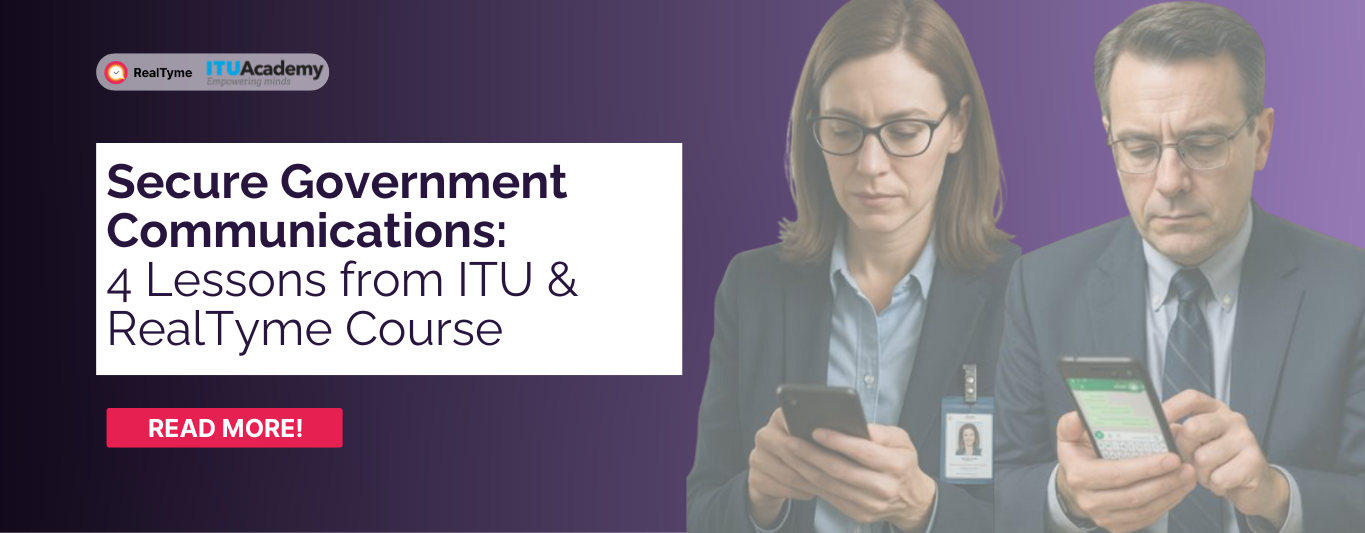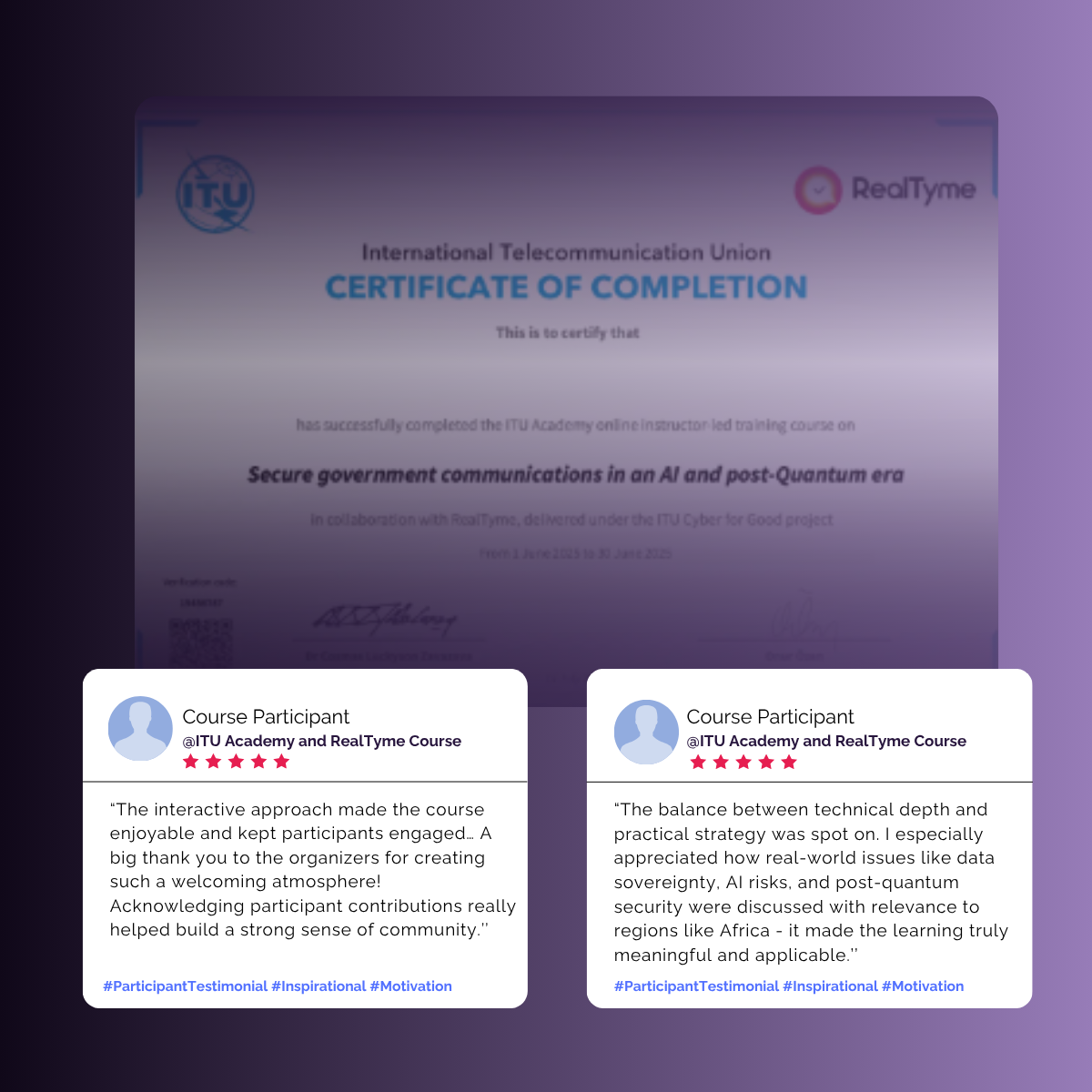Secure Government Communications: 4 Lessons from ITU & RealTyme Course

What did 70+ members of governments, cybersecurity agencies and regulatory bodies learn in a multi-session masterclass on digital sovereignty? Here are the urgent takeaways.
In 2025, the digital battlefield shifted.
State-sponsored cyberattacks, AI-driven disinformation, and looming quantum threats pushed secure government communication from an IT concern to a national security imperative.
It’s no longer just about how governments speak to citizens. It’s about how they speak within themselves — securely, sovereignly, and sustainably.
That’s the context in which ITU Academy, the educational arm of the United Nations’ International Telecommunication Union, partnered with RealTyme, a sovereign and secure communication platform provider, to launch a unique, free, multi-part course for policymakers, technologists, and government leaders.
Its goal: to future-proof the foundations of public sector communications.
This wasn’t a routine cybersecurity course. The program was more than a series of lectures. It was a strategic, geopolitical, and technological deep dive into the fragility and fixability of government communications in an age of disruption.
Now that the course has concluded, we distill its biggest lessons. These aren’t just technical suggestions. They’re imperatives for any government serious about security, sovereignty, and long-term digital resilience.
If you're responsible for your government's communications, consider this your briefing.

Lesson 1: Your Infrastructure Is Your Foreign Policy
In diplomacy, symbols matter: national flags, embassies, carefully worded communiqués. But beneath the visible rituals of statecraft lies a quieter, more consequential declaration of allegiance: your technology stack.
From messaging platforms to cloud storage, the infrastructure governments use to communicate reveals who they depend on. And that dependence isn't neutral. In fact, it may already be compromising sovereignty.
At first glance, legacy platforms seem dependable. They’ve stood the test of time. They’re familiar. But that’s exactly the danger.
These systems were built before encryption was standard, before metadata was recognized as a strategic vulnerability, and long before nation-state adversaries weaponized communications infrastructure. They are trusted, but fundamentally untrustworthy.
During the first session of the ITU and RealTyme course, participants explored real-world examples where outdated or foreign-controlled tools created silent, yet systemic risks. In one case, a widely used document-sharing platform was found to route traffic through data centers governed by adversarial surveillance laws. This was a failure of jurisdictional control.
Experts revealed how even encrypted legacy systems could be exploited through metadata collection or hidden update mechanisms. From compromised diplomatic cables to subtle behavioral mapping via innocuous collaboration tools, the pattern was clear:
Every message sent over a legacy system is a potential vulnerability exposed.
RealTyme’s guidance is unambiguous: Treat communication platforms not as commodity software, but as sovereign infrastructure. Because when crises strike and every second matters, you need to know not only what tools you're using, but whose legal frameworks and political incentives underpin them.
Without sovereign control of your communication stack, you’re not just behind. You’re exposed.
The Hidden Risks
- Even encrypted systems can leak metadata.
- Update mechanisms can introduce vulnerabilities.
- Jurisdictional control can override technical protections.
What Sovereign Infrastructure Looks Like
- End-to-end encryption with forward secrecy
- Vendors aligned with national interests
Key Takeaway from the course: Communication platforms aren’t commodity software. They’re sovereign infrastructure. Treat them accordingly.
Lesson 2: Data Ownership Is the New Sovereignty
In the analog era, sovereignty was marked by physical control: borders, flags, institutions.
In the digital age, sovereignty is measured by something far less visible: control over data, infrastructure, and cryptographic authority.
Many governments today believe they have control. They’ve implemented data localization policies, mandated encryption, and procured tools from vetted vendors.
But as participants in the ITU and RealTyme course discovered in Session 2, the real threats to digital sovereignty don’t come from obvious vulnerabilities. They come from the silent, often contractual ones.
In Session 2, the conversation shifted from tools to power. Specifically: Who owns the data governments generate, share, and store every day?
It’s a harder question than it seems.
While some agencies have made progress with data residency laws or “sovereign cloud” contracts, few fully grasp the difference between data storage and data control.
Consider this:
- If a third-party vendor holds your encryption keys, is your data really yours?
- If your internal communications generate behavioral metadata stored in foreign data centers, who has insight into your institutional habits?
- If your update pipeline is dependent on a non-domestic provider, what happens during geopolitical tension?
In practice, governments have built digital infrastructure on layers of invisible dependencies, from messaging platforms hosted on foreign soil to productivity suites governed by terms of service that can be rewritten without consent.
Key takeaway from the course: Sovereignty is not just about where your data lives. It’s about who decides what happens to it, and when.
Participants examined case studies showing how even encrypted communication tools can be subverted when metadata is sold, when backdoors are implemented via updates, or when legal jurisdictions shift.
Real Sovereignty = Engineered Sovereignty
RealTyme’s stance was clear: sovereignty must be engineered. That means:
- Architectures where keys are institutionally owned, not held in escrow by vendors;
- Infrastructure that doesn’t rely on unverifiable third-party plug-ins or dynamic external APIs;
- Update protocols that governments can vet, schedule, and block, not silently installed patches.
As the session made clear: without full-stack transparency and control, you're not running a secure system You're leasing one. And in moments of geopolitical tension, those leases can expire without warning.
Lesson 3: Post-Quantum, AI and The Future of Government Threats
Quantum decryption. AI-generated impersonations. Behavior-targeted phishing. These are strategic threats accelerating toward the public sector faster than most governments can respond.
In Session 3 of the ITU and RealTyme course, participants explored the convergence of two transformational, and highly disruptive, forces: post-quantum computing and artificial intelligence.
The implications were clear: modern communication systems must be built not just for current threats, but for ones we can already see forming on the horizon.
Consider the tactic known as "harvest now, decrypt later." State and non-state actors are already intercepting encrypted communications with the expectation that, once quantum computing matures, today's secrets will become tomorrow’s intelligence goldmine.
Encrypted diplomatic memos, sensitive contracts, classified operational data, all assumed secure in 2025, could be exposed by 2032.
The parallel rise of generative AI compounds the risk. Participants reviewed examples of:
- Deepfake audio messages imitating political leaders during crises;
- Synthetic phishing campaigns generated and targeted at scale;
- Fake press releases crafted to manipulate markets or diplomatic relations.
These are tools of psychological warfare, destabilization, and hybrid conflict. Traditional security measures, even strong encryption, are insufficient.
The key takeaway: Resilience requires crypto agility.
Crypto-agile systems are designed to adapt rapidly to evolving cryptographic standards, including the integration of post-quantum algorithms.
They don’t just defend against today’s known threats. They position governments to absorb shocks from tomorrow’s breakthroughs.
RealTyme’s response, detailed during the session, is multi-layered:
- Hybrid post-quantum encryption embedded into its core protocols;
- AI anomaly detection systems capable of identifying suspicious behavioral patterns;
- Integrated identity assurance to verify users across multiple vectors, resisting impersonation.
Most importantly, these features aren’t optional add-ons. They’re foundational. Because in an age where threats mutate faster than regulatory frameworks can adapt, security has to be dynamic, not reactive.
Lesson 4: Trust Is the Infrastructure We Forgot to Protect
Technology might be developed in silos, but resilience is a collective effort.
Throughout the course, one recurring theme echoed in every discussion: fragmented approaches to secure communications are inherently vulnerable.
A single nation might adopt strong cryptographic standards.
But if it communicates with partners who haven’t, its exposure remains.
If it adopts zero-trust internally but shares data through insecure channels, its gains are lost.
That’s why collaboration was a core element of the course.
Across sessions, we discussed how to:
- Co-develop regional communication protocols that ensure both security and interoperability;
- Harmonize regulatory definitions of secure messaging and digital identity;
- Establish cross-border trust frameworks without compromising national key ownership;
- Enable sovereign deployments — so each government can operate on infrastructure it controls while maintaining interoperability with trusted partners.
RealTyme’s model supports this through flexible deployment options:
- Fully on-premises installations for critical ministries and classified environments that demand absolute isolation.
- Sovereign cloud deployments within national data centers or under local jurisdictional control.
- Swiss cloud hosting options — offering politically neutral, GDPR-compliant, and security-certified infrastructure based in Switzerland, for governments seeking trusted external deployment without foreign surveillance exposure
This approach allows each government to maintain full control over data, encryption keys, identity assurance, and update schedules, while still participating in secure intergovernmental collaboration.
.png)
Final Reflections: From Training to Transformation
What this course series made abundantly clear is that government communications are not a neutral technical concern. They are:
- A vector of geopolitical risk — where adversaries don’t need to hack your files if they can analyze your metadata.
- A foundation of institutional trust — where citizens expect their governments to protect not just borders, but digital backbones.
- A mirror of national digital maturity — revealing whether a government is shaping the future or lagging it.
The future will not be kind to passive governments. Only those who recognize communications infrastructure as a strategic asset, one that must be sovereign, secure, and forward-compatible, will retain the trust of their citizens and the confidence of their allies.
The ITU and RealTyme course was just the beginning. If you’re a member of the government, cybersecurity agency or regulatory body, the work starts now.
If you’re ready to take the next step, here’s how to stay ahead:
Download the Free Guide to Secure Messaging for Government Agencies
Want a deeper technical blueprint for modernizing your communications infrastructure?
➡️ Download the free Guide to Secure Messaging for Government Agencies
This free resource covers encryption standards, metadata risks, and actionable frameworks for sovereign and secure communication.
Get Involved
Now, it's time to act.
Join a growing community of policymakers, technologists, and public sector leaders who are shaping the future of secure governance. Stay informed on upcoming courses, global standards efforts, and expert briefings.
Want to bring this course to your region?
Need help designing a sovereign, secure communication stack?
Curious how your current systems stack up?
👉 Contact RealTyme to request a strategy session or regional training partnership.
.png)
.png)

